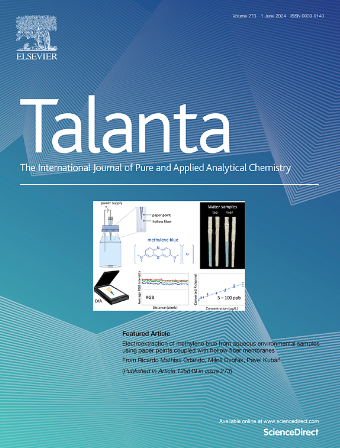Deep eutectic solvent-based green extraction of Strychnos potatorum seed phenolics: Process optimization via response surface methodology and artificial neural network
IF 5.6
1区 化学
Q1 CHEMISTRY, ANALYTICAL
引用次数: 0
Abstract
The current research focused on extraction optimization of bioactive compounds from Strychnos potatorum seeds (SPs) using an eco-friendly glycerol-sodium acetate based deep eutectic solvent (DES). The optimization was accomplished using response surface methodology (RSM) and artificial neural networking (ANN). The independent variables included shaking time (A), temperature (B), and solvent-to-feed ratio (C), and the responses were the extraction yield, total phenolic content (TPC), total flavonoid content (TFC), antioxidant activity (DPPH), and antidiabetic activity (α-amylase inhibitory activity). The SPs extracts obtained under optimal conditions (29 min, 40 °C and 30 mL/g of A, B, and C parameters, respectively) had 30.43 mg gallic acid equivalents (GAE)/g of dry weight (DW) TPC, 10.99 mg rutin equivalents (RE)/g DW TFC, 26.16 % antioxidant activity and 46.95 % α-amylase inhibitory activity. For all the outputs, the ANN percentage error was less than the RSM percentage error for the predicted values against the experimentally measured values. The results were further supported by the %AAD (% absolute average deviation) and R2 values obtained from RSM and ANN methods. The %AAD for TPC, TFC, DPPH, and α-amylase inhibitory activity by RSM was 7.31, 4.80, 4.03, and 4.36, while by ANN, it was 1.18, 3.90, 1.99, and 2.97, respectively. It is worth noting that despite no statistical difference between the two predictive models, ANN gave closer results to the experimental values. Correlation among various response types showed that TPC and TFC were strongly correlated. This research highlights the efficiency of glycerol-sodium acetate DES as an extractant.

深共熔溶剂法提取马铃薯马钱子酚类物质:响应面法和人工神经网络工艺优化。
目前研究的重点是采用环保型甘油-乙酸钠基深度共熔溶剂(DES)对马钱子种子(SPs)中生物活性物质的提取工艺进行优化。采用响应面法(RSM)和人工神经网络(ANN)进行优化。以振荡时间(A)、温度(B)和料液比(C)为自变量,分别为提取率、总酚含量(TPC)、总黄酮含量(TFC)、抗氧化活性(DPPH)和抗糖尿病活性(α-淀粉酶抑制活性)。在最佳条件下(A、B、C分别为29 min、40℃和30 mL/g)得到的SPs提取物,其没食子酸当量(GAE)/g干重(DW) TPC、芦丁当量(RE)/g DW TFC分别为30.43 mg、10.99 mg、26.16%的抗氧化活性和46.95%的α-淀粉酶抑制活性。对于所有的输出,人工神经网络的百分比误差小于相对于实验测量值的预测值的RSM百分比误差。RSM和ANN方法得到的%AAD(%绝对平均偏差)和R2值进一步支持了结果。RSM对TPC、TFC、DPPH和α-淀粉酶抑制活性的%AAD分别为7.31、4.80、4.03和4.36,ANN的%AAD分别为1.18、3.90、1.99和2.97。值得注意的是,尽管两种预测模型之间没有统计学差异,但人工神经网络给出的结果更接近实验值。各反应类型间的相关分析表明,TPC与TFC呈强相关。本研究强调了甘油-乙酸钠DES作为萃取剂的效率。
本文章由计算机程序翻译,如有差异,请以英文原文为准。
求助全文
约1分钟内获得全文
求助全文
来源期刊

Talanta
化学-分析化学
CiteScore
12.30
自引率
4.90%
发文量
861
审稿时长
29 days
期刊介绍:
Talanta provides a forum for the publication of original research papers, short communications, and critical reviews in all branches of pure and applied analytical chemistry. Papers are evaluated based on established guidelines, including the fundamental nature of the study, scientific novelty, substantial improvement or advantage over existing technology or methods, and demonstrated analytical applicability. Original research papers on fundamental studies, and on novel sensor and instrumentation developments, are encouraged. Novel or improved applications in areas such as clinical and biological chemistry, environmental analysis, geochemistry, materials science and engineering, and analytical platforms for omics development are welcome.
Analytical performance of methods should be determined, including interference and matrix effects, and methods should be validated by comparison with a standard method, or analysis of a certified reference material. Simple spiking recoveries may not be sufficient. The developed method should especially comprise information on selectivity, sensitivity, detection limits, accuracy, and reliability. However, applying official validation or robustness studies to a routine method or technique does not necessarily constitute novelty. Proper statistical treatment of the data should be provided. Relevant literature should be cited, including related publications by the authors, and authors should discuss how their proposed methodology compares with previously reported methods.
 求助内容:
求助内容: 应助结果提醒方式:
应助结果提醒方式:


